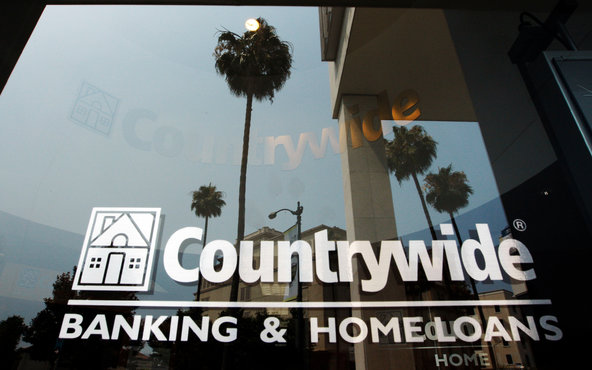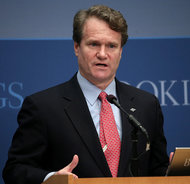 Kevork Djansezian/Associated PressBank of America bought Countrywide in 2008.
Kevork Djansezian/Associated PressBank of America bought Countrywide in 2008.
11:38 a.m. | Updated
Bank of America agreed on Monday to pay more than $10 billion to Fannie Mae to settle claims over troubled mortgages that soured during the housing crash, mostly loans issued by the bank’s Countrywide Financial subsidiary.
Separately, federal regulators reached an $8.5 billion settlement on Monday to resolve claims of foreclosure abuses that included flawed paperwork used in foreclosures and bungled loan modifications by 10 major lenders, including JPMorgan Chase, Bank of America and Citibank. About $3.3 billion of that settlement amount will go toward Americans who went through foreclosure in 2009 and 2010, while $5.2 billion will address other assistance to troubled borrowers, including loan modifications and reductions of principal balances. Eligible homeowners could get up to $125,000 in compensation.
The two agreements are not directly related, but they illustrate the extent of the banks’ role in the excesses of the credit boom, from the making of loans to the seizure of homes.
Related Links
 Documents: News release from Bank of America
Documents: News release from Bank of America Documents: News release on foreclosure abuse settlement
Documents: News release on foreclosure abuse settlement
Under the terms of the Bank of America deal, the bank will pay Fannie Mae $3.6 billion and will also spend $6.75 billion to buy back mortgages from the housing finance giant.
The settlement will resolve all of the lender’s disputes with Fannie Mae, removing a major impediment to Bank of America’s rehabilitation. The bank had settled its fight with Freddie Mac, the other government-owned mortgage giant, in 2011.
Both Fannie and Freddie, which have posted billions of dollars in losses in recent years, have argued that Countrywide misrepresented the quality of home loans that it sold to the two entities at the height of the mortgage bubble. Bank of America assumed those troubles when it bought Countrywide in 2008.
 Win McNamee/Getty ImagesBrian Moynihan, chief of Bank of America.
Win McNamee/Getty ImagesBrian Moynihan, chief of Bank of America.
Before the latest settlement announced on Monday, the Countrywide acquisition had cost Bank of America more than $40 billion in losses on real estate, legal costs and settlements, according to several people close to the bank.
By removing part of the bank’s mortgage albatross, the move is a continued retreat from home lending by Bank of America, even as rivals including JPMorgan Chase and Wells Fargo compete for the profitable refinance business that has boomed with interest rates persistently low.
Bank of America also agreed to sell the servicing rights on about $306 billion worth of home loans to other firms. In separate statements, Nationstar Mortgage Holdings and the Newcastle Investment Corporation announced they were buying the rights. Those servicing costs, which were roughly $3.4 billion in the third quarter, have weighed on the bank’s profits, especially as borrowers fall behind on their bills.
Brian T. Moynihan, the bank’s chief executive, said in November that he intended to sell off about two million loans the bank currently serviced.
“Together, these agreements are a significant step in resolving our remaining legacy mortgage issues, further streamlining and simplifying the company and reducing expenses over time,” Mr. Moynihan said in a statement on Monday.
Bank of America said it expected the settlement to hurt its fourth-quarter earnings by $2.5 billion because of costs tied to foreclosure reviews and litigation. The firm also expects to record a $700 million charge, an accounting move known as a debt-valuation adjustment, related to an improvement in the prices of its bonds.
The deal on Monday helps the bank move away from its troubled mortgage business. Still, the bank’s attempts to resolve other costly mortgage litigation have so far been stymied. Looking to appease investors that sued the bank for losses when mortgages packaged into securities imploded during the financial crisis, the bank agreed to pay $8.5 billion in June 2011. But the settlement, which would help mollify investors including the Federal Reserve Bank of New York and Pimco, has been stalled.
Further thwarting Bank of America’s retreat from the mortgage business, federal prosecutors sued the bank in October, accusing it of churning through loans so quickly that quality controls were virtually forgotten. The Justice Department sued the bank under a law that could mean Bank of America could pay well more than $1 billion to settle.
Bank of America has been embroiled with other legal woes, including accusations that it misled investors about the acquisition of Merrill Lynch. Shareholders, led by pension funds, had said the bank provided false and misleading statements about the health of the Wall Street firm, which, unknown to the public, was racking up huge losses in late 2008 amid turmoil in the markets.
The separate agreement with 10 banks on foreclosure abuses concludes weeks of feverish negotiations between the federal regulators, led by the Office of the Comptroller of the Currency, and the banks. That settlement will end a troubled foreclosure review mandated by the banking regulators.
The deal, which was hashed out over the weekend, had teetered on the brink of collapse after officials from the Federal Reserve demanded that the banks pay an addition $300 million to address their part in the 2008 financial crisis, according to several people briefed on the negotiations who spoke on condition of anonymity.
The Federal Reserve, though, agreed to back down on the demands in the hope that the pact could move ahead and bring more immediate relief to homeowners struggling to stay afloat in a time of persistent unemployment and a sluggish economy.
The multibillion-dollar foreclosure settlement was driven, to a large extent, by banking regulators, who decided that a review of loan files was inefficient, costly and simply not yielding relief for homeowners, these people said. The goal in scuttling the reviews, which were mandated as part of a consent order in April 2011, was to provide more immediate relief to homeowners.
The comptroller’s office and the Federal Reserve said on Monday that the settlement “provides the greatest benefit to consumers subject to unsafe and unsound mortgage servicing and foreclosure practices during the relevant period in a more timely manner than would have occurred under the review process.”
The relief will be distributed to homeowners even if they did not file a claim for their loan files to be reviewed.
Concerns about the Independent Foreclosure Review began to mount in within the comptroller’s office, according to the people familiar with the matter. The alarm, these people said, was that the reviews were taking more than 20 hours a loan file at a cost of up to $250 an hour. Since the start of the review, the banks, which are required to pay for consultants to review the files, had spent an estimated $1.5 billion.
More vexing, the banking regulators said that the reviews were not providing any relief to borrowers or turning up meaningful instances where homes of borrowers current on their payments were seized, according to these people.
Michael J. de la Merced and Ben Protess contributed reporting.
Article source: http://dealbook.nytimes.com/2013/01/07/bank-of-america-to-pay-10-billion-in-settlement-with-fannie-mae/?partner=rss&emc=rss
Speak Your Mind
You must be logged in to post a comment.